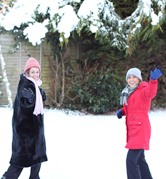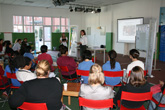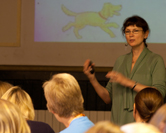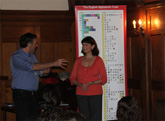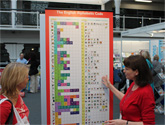 |
PICTURE POSTERS
Simple
phonemic awareness posters illustrating the relationship between sounds (phonemes) in words and
letters(graphemes) in written words. The words are non-cumulative as the learner is not expected to
decode these words. This strand runs through units 1 - 6. |
|
 |
ALPHABETIC CODE FRIEZE
POSTERS
A4 frieze posters for every new grapheme (letter or letter group)
introduced. Lower case grapheme is highlighted. Relative sizes and position of capital letters and
lower case letters are shown on a writing line. In units 1 - 12. |
|
 |
ALPHABETIC CODE FRIEZE POSTERS -
EXTRAS
Six additional A4 frieze posters with examples of
long vowel sounds represented by the single letters a, e, i, o, u, y. These are /ai/ as in table,
/ee/ as in emu, /igh/ as in behind, /oa/ as in yo-yo, /yoo/ as in unicorn and /igh/ as in fly.
Lower case grapheme is highlighted. Relative sizes and position of capital letters and lower case
letters are shown on a writing line. Alphabetic Code Frieze Posters are provided in units 1 to
12. |
|
 |
GROUPING THE SPELLING ALTERNATIVES POSTERS
These
A4 posters (62 throughout the 12 units) group the spelling alternatives for the focus sounds in
each unit. They can be used to complement the main ALPHABETIC CODE OVERVIEW CHART and THE
ALPHABETIC CODE FRIEZE POSTERS. From unit 7 onwards, a spelling alternative is occasionally
included on a poster in advance of its formal introduction in a later unit. This helps with
raising awareness of spelling alternatives for reading and writing activities in the wider
curriculum. (Please see the DRAW THE PICTURES resource which provides an optional activity for
the learner to embed the Alphabetic Code information in memory.) |
|
 |
MINI-POSTERS
Simple posters to track the sounds in spoken words with the letters in written words. The words start
off being non-cumulative - but after the first few posters, all the words are cumulative. A good time
to introduce each poster is just before you introduce and use each Sounds Book Activity Sheet. This
strand continues throughout the programme in units 1 - 12. |
|
 |
SOUNDS BOOK ACTIVITY
SHEETS
Debbie's programme is built around these essential activity sheets. With
each successive sheet, a new letter/s-sound correspondence is introduced; cumulative words are
provided for blending; handwriting practice links shape to sound; picture drawing provides phonemic
awareness rehearsal, pencil control, vocabulary development and a personal mnemonic system; and a
segmenting, handwriting and editing routine rehearses spelling. Thus, all the necessary knowledge
and skills teaching and learning is focused on one activity sheet! Each sheet includes detailed
guidance and, when used in school, these activity sheets can be sent home to inform parents and
guardians. This strand runs throughout units 1 - 12. |
|
 |
COLOUR-IN SOUNDS
BOOK
The A5 Colour-in Sounds Book sheets include a key word (non-cumulative)
with a key colour-in picture and three cumulative words to blend (some non-cumulative words in unit
1). ‘Tracker font’ provides some handwriting practice for the focus grapheme. These can be used
when new letter/s-sound correspondences are introduced. They can be collated in a scrap book to
make a ‘Code Book’ or ‘Sounds Book’. Provided in units 1 to 12. |
|
 |
PICTURE CARDS
These
are pictures to raise awareness of the individual sounds, or phonemes, that make up spoken words.
They can be used in many different ways including using them along with the phonemic awareness
Picture Posters. This strand runs throughout Units 1 - 6. |
|
 |
GUIDANCE FOR USING THE PICTURE
CARDS
Sets of the PICTURE CARDS are available in units 1 to 6 for developing
phonemic awareness (the awareness of sounds within words). This resource is TEACHERS’ GUIDANCE and
is available for supporting the use of each set of the Picture Cards in units 1 to 6. Examples are
provided of how spoken words can be segmented (split up) into their constituent phonemes (sounds).
Note that the phonemes are denoted between slash marks in this guidance and that this is for the
teachers’ information and use - NOT for the learners! |
|
 |
GRAPHEME TILES (BLACK/GREY) - ALSO IN
DARK TEAL
Ideal sized grapheme tiles for manipulating words (making and
breaking). These can be used for various spelling activities including making up independent
spelling games with selected Picture Cards. They would be better printed on card or laminated.
Ideally laminated Grapheme Tiles could be made into magnetic tiles with sticky-backed magnetic
tape. They can then be used on the teacher’s main magnetic board or with A3 magnetic board for
pairs or individual work. The Grapheme Tiles are printable in all ‘dark teal’ (which can be black
if printed in monochrome) and they are available in sets with grey graphemes for consonant phonemes
and black graphemes for vowel phonemes. These are also suitable for sending home for additional
word making and breaking rehearsal. They would be suitable for ‘fridge magnets’. Provided as sets
per each unit 1 to 12. |
|
 |
LETTERS, SOUNDS AND PICTURES MATCHING
GAME
A cumulative card game provided on 21 x A4 sheets spread over units 1 to 6.
This game is ideal for supporting the learning of the sub-skills for decoding (reading) and
encoding (spelling). In total there are 105 pictures each with teacher clue cards and grapheme
cards. The teacher cards provide full information for segmenting the focus word. The set of cards
in each unit includes an information sheet. Use this game to support the main teaching of new
letter/s-sound correspondences. In units 1 to 6. |
|
 |
PAIRS GAME (qu, ou, ow, oi, oy, ue, er,
ar, ce, se, ge, j)
Graphemes appropriate to each unit are presented
on writing lines for playing the Pairs Game (instructions included). These can also be used as
general grapheme tiles for word making and breaking. Print on card or laminate for school use
and/or send home as paper-based game to aid new learning. Highlights that capital letters are the
same code for sounds as lower case letters. Provided in units 1 to 6. |
|
 |
SAY THE SOUNDS
BOOKLET
These A5 booklets are designed for learners to rehearse and learn the
latest letter/s-sound correspondences to automaticity. The pages of the booklets are clipped
together with a paper clip and the teacher releases each page as the new correspondence is
introduced. The booklet can go between school and home for ‘little and often’ practice of saying
the sounds. There is a list of all the letters/s-sound correspondences of the unit at the back of
each booklet for a final assessment. To make the booklet, slice the A4 pages in half (now creating
2 x A5 sheets), put the letter/s-sound correspondences in the order that they are introduced in the
programme with the A5 sheet of all the graphemes at the back. Staple the left-hand side to make the
booklet. There is one booklet each for units 1 to 5 and two booklets for unit 6. |
|
 |
SAY THE SOUNDS
POSTERS
Three 'Say the Sounds' Posters per unit for units 1 - 5. The first three
are included in unit 1. These are very useful cumulative resources. They can be A4 or A3 posters
displayed in the classroom for learners to point and 'say the sounds' (subskill of reading) or the
teacher can say the sound and ask the learner to 'point to the grapheme' in response (subskill of
spelling). In addition, paper versions of the Say the Sounds Posters can be used as assessment
sheets for each learner. Name, date and mark in a different coloured pen for ongoing assessments.
Provide an unmarked copy for the learner to use for actual assessment. Beginners will benefit from
a copy of a Say the Sounds Poster used alongside the Alphabetic Mini Poster (below) to support
writing activities during the STAGE ONE phase of learning. These posters are also available in the
STAGE TWO phase of learning in units 6 to 12. |
|
 |
SPELLING SHEETS WITH WORD CHECK LIST (can
also be used as a RECORD-KEEPING LIST)
This strand includes 40 different
Spelling Sheets spread over the first six units. They are best used once learners have a good grasp
of the segmenting skill, and they are familiar with the Alphabetic Code knowledge taught to date,
therefore consider using them at the end of each unit. In these spelling activities, pictures
provide the stimulus for spelling words. Grapheme lists and sound-dashes are provided to support
the spelling process. At first the learner can ‘say the sounds’ for the graphemes listed at the top
of the spelling sheets. The graphemes list can also be used to select GRAPHEME TILES or magnetic
letters or CanDoCubes for an optional kinaesthetic spelling activity instead of, or prior to,
writing down the spellings. For a more challenging activity, fold over or cut off the graphemes
list for learners to spell without sight of them. Available in units 1 to 6. |
|
 |
GRAPHEME FLASH CARDS WITH
PICTURES
These are OPTIONAL ‘beginners’ flash cards in units 1 to
5. When the learner can recognise a letter shape (or letter group) WITHOUT the picture mnemonic,
replace that card with a flash card of the letter/s (graphemes) only. Start off by BUILDING UP the
pack of flash cards as you introduce each new letter/s-sound correspondence. In unit 1, for
example, at first there will only be ‘s’ in the pack, followed by introducing ‘a’, then ‘t’, then
‘i’ and so on (follow the order of the programme). The aim is for the beginner, as soon as
possible, NOT to use the picture cues. Focus on the AIM of saying the sound in response to the
letter/s without the need for the pictures. Make it clear to the beginner whether the corresponding
‘sound’ represented by the focus letter/s (graphemes) is at the beginning of the word (as in
‘s-nake’) or in the middle of the word (as in ‘n-igh-t’) or at the end of the word (as in ‘du-ck’).
The dashes on some cards represent the number of ‘sounds’ in the spoken word and NOT individual
letters - this is just to support the ‘mapping’ of initial-medial-final sounds to their position in
the spoken word. The Flash Cards with no pictures are included as part of this resource. In units 1
to 5. |
|
 |
MY WORDS - WORD
LISTS
A massive cumulative word bank to rehearse blending at word level, plus a
blank pro forma for copywriting and spelling. This strand runs throughout units 1 - 6. |
|
 |
BLEND WORD CARDS
Blend
Word Cards include words from the cumulative word bank provided with no distinctive shading or
colouring to indicate specific graphemes. In this way it emulates ordinary print. Ideally these
cards should be printed on card or laminated. They can be used to rehearse word level blending but
can also be used to identify and sort words with different spelling alternatives. Selected cards
can make up games with the Picture Cards for matching the correct word to the correct picture. They
can also be used for partner work where one partner reads the word for the other partner to go
through the spelling routine and write the word. Provided in units 1 to 6. |
|
 |
I CAN READ, WRITE AND
DRAW
These activity sheets include a limited number of selected cumulative words
for the learner to blend, to write under carefully on a writing line, and then to discuss the
meaning, or possible meanings, of the word with the teacher. The learner then draws pictures to
illustrate the meanings of the word. Provided in units 1 to 6. |
|
 |
READ THE WORDS - MAKE UP A
STORY
Rehearse the letter/s-sound correspondence introduced the previous day
with some phonic-based handwriting. Both learner and teacher have words to blend. The learner's
words are cumulative (from the 'ck' poster) and the teacher models the blending of enrichment
words. The most important aspect is the speaking and listening and vocabulary development
opportunity as teacher and learner share the creation of a story and illustrate it. This strand
runs throughout units 1 - 6. |
|
 |
I CAN READ
This is a
piece of text for every new correspondence after the introduction of the first few letters. Delay
the use of this strand until learners can blend. There are many different ways to use the text from
teacher modelling, supported reading, independent reading followed by a focus on vocabulary and
comprehension. The texts can be read on-screen or, where available, projected onto a whiteboard or
screen for groups and whole-class work. When used as a paper-based activity, the learner can
undertake grapheme searches for previous and current learning and circle words where the meaning is
not known. This strand runs throughout units 1 - 12 with a change of fonts in units 11 and
12. |
|
 |
HEAR THE SOUNDS
Hear the same phonemes modelled in all positions in the words which feature on the phonemic awareness
Picture Posters. This facility is available for units 1 - 6. (Switch on PC speakers!) |
|
|
|
|

